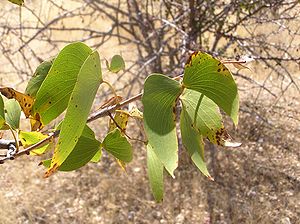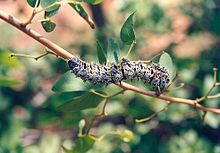Mopane
| Mopane | ||||||||||||
|---|---|---|---|---|---|---|---|---|---|---|---|---|

Mopane ( Colophospermum mopane ) |
||||||||||||
| Systematics | ||||||||||||
|
||||||||||||
| Scientific name of the genus | ||||||||||||
| Colophospermum | ||||||||||||
| J.Kirk ex J.Léonard | ||||||||||||
| Scientific name of the species | ||||||||||||
| Colophospermum mopane | ||||||||||||
| (J.Kirk ex Benth. ) J.Léonard |
The Mopane ( Colophospermum mopane ), also called Mopani , is the only species of the Colophospermum plant genus that belongs to the legume family (Fabaceae). The plant is widespread in southern Africa .
description
Vegetative characteristics
The Mopane grows as a more or less deciduous shrub or tree in the dry season , which in the northern distribution area reaches heights of up to 22-24 meters under the best growing conditions. Plant parts, especially the leaves, give off a turpentine odor when injured . Its trunk, which is up to 50–100 centimeters thick, has a very typical rough, grayish-brown, thick bark with deep, vertical furrows, stripes and coarse scales. The large treetop is narrow. The tree provides a resin , copal .
The twofold, stalked and alternate leaves look like camel footprints or butterfly wings and fold up when the heat is intense. The bald petiole is about 1.5–4.5 inches long. There is still a small tip at the end of the foliage leaf, which represents a reduced third leaflet. The oblique-egg-shaped to triangular or crescent-shaped to sickle-shaped triangular and seated leaflets are leathery as well as glabrous and entire. They are rounded to rounded at the tip, and a pulvinus is formed at the base . They are about 4-11 centimeters long and the vein is multi-veined, palmate. The leaves are beautifully colored in autumn and spring. The stipules fall off early. The glandular leaves smell of turpentine. The young leaves are reddish.
Generative characteristics
The flowering period extends from December to January. Axillary and racemose to paniculate , short inflorescences with a few flowers are formed. The relatively small, hermaphroditic, stalked flowers with a simple envelope are green-yellowish, the petals are missing. Most of the 4 sepals are rounded and boat-shaped and later put back. There are many (20-25) free, droopy stamens with filamentous stamens and anthers large and a top constant laterally flattened and bald ovary present. The side stylus bears a broad, wrinkled scar .
Between April and June the flat, somewhat kidney to crescent-shaped, glandular and papery, non-opening legumes ripen and turn from green to light and later speckled brown; they contain only one seed. They are about 3–6 inches long and smell like turpentine. The flat, often slightly curved, 1.5–2.5 cm long, light seeds with deep folds and wrinkles have numerous yellowish to reddish and sticky glands. The sticky seeds stick to the hooves of passing animals and thus spread epichorically or with the wind .
Chromosome number
The number of chromosomes is 2n = 34 (or 36).
Synecology
The Mopaneblätter serve many herbivores such as elephants , giraffes and black rhinos as nutritious fodder .
Occurrence
Colophospermum mopane is distributed in southern Africa in the northernmost area of the Republic of South Africa (near the Limpopo River ), in Zimbabwe , Mozambique , Botswana , Zambia , Namibia , Angola and Malawi . The mopane thrives in hot, dry areas at altitudes between 200 and 1500 meters.
It is found on thin, poorly draining, alkaline (high proportion of lime) soils . Here it often spreads to form mopane forests. It also grows on areas washed up by rivers .
In South Africa and the neighboring areas of Botswana and Zimbabwe, the trees vary in size from 4 to 18 m and are called mopane shrubs, sometimes they also form groves if they are slimmer. Mopane does not grow well outside of the hot, frost-free areas with summer rain that are convenient for it.
Systematics
The first description was in 1866 under the name ( Basionym ) Copaifera mopane by George Bentham after John Kirk in Transactions of the Linnean Society of London 25, p. 317. The genus Colophospermum was in 1949 after John Kirk in 1866 by Jean Joseph Gustave Léonard in Bulletin du Jardin Botanique de l'État 19, 390 with the type species Colophospermum mopane (J.Kirk ex Benth.) J.Léonard introduced. Colophospermum mopane is the only species of the genus Colophospermum from the tribe Detarieae in the subfamily Caesalpinioideae within the Fabaceae family . This species is sometimes in the genus Hardwickia Roxb. classified.
Other synonyms are: Copaiba mopane (Kirk ex Benth.) Kuntze and Hardwickia mopane (Kirk ex Benth.) Breteler
The genus name Colophospermum is derived from the Greek words colophos for " colophony " and spermum for seeds, which apparently refers to the resinous, sticky seeds (rosin is sticky).
use

Together with camel thorn ( Acacia erioloba ) and the ancestral tree ( Combretum imberbe ), it forms the triad of firewood for people in southern Africa.
The leaves are food for the caterpillar of Gonimbrasia belina , a moth from the peacock moth family . Because of their high protein content, these caterpillars are roasted, dried or eaten in "Mopane worm soup" by humans. Collecting caterpillars is an important source of income for many people. The leaves also serve as food for Gonometa rufrobrunea which produces wild silk .
The bark is used for making cords and for tanning . The leaves are used to heal wounds and combat stomach problems.
Traditionally, mopane wood is used to build houses and for kraal fences , and the twigs are chewed as a toothbrush. The hard, reddish and very heavy wood ( ironwood ) was used for railway sleepers and for excavating mine tunnels. It is one of the heaviest woods in southern Africa and is obviously difficult to work with due to its hardness. But that is precisely what makes it termite-resistant , which is why it is often used for fence posts and floor coverings.
Mopane has an average density of 1075 kg / m³.
In recent times, mopane wood has become more and more popular in woodwind instrument making as a possible substitute wood for grenadilla ( Dalbergia melanoxylon ), as it is, like this, very hard and dense and also has similarly advantageous tonal properties, for example with the clarinet makers Schwenk & Seggelke and F. Arthur Uebel . In addition, no significant allergic reactions to Mopane wood are known to date, which, however, often occurs with the various Dalbergia species.
The roots are used in terrariums and aquariums because of their high weather resistance .
Individual evidence
- ↑ a b Mopane on wood-database, accessed on March 7, 2017.
- ↑ Colophospermum mopane at Tropicos.org. In: IPCN Chromosome Reports . Missouri Botanical Garden, St. Louis
- ↑ Colophospermum in the Germplasm Resources Information Network (GRIN), USDA , ARS , National Genetic Resources Program. National Germplasm Resources Laboratory, Beltsville, Maryland.
literature
- N. Esterhuyse, J. von Breitenbach, H. Söhnge: Remarkable trees of South Africa. Briza Publications, Pretoria 2001, ISBN 978-1-920217-66-2 .
- C. Trippner: Soil ecological studies in selected model areas in the Etosha National Park / Northern Namibia, with special consideration of the ecological-pedological risks and the location requirements of Colophospermum mopane. XIV, 263 p .: graph. Darst. Thesis (dissertation): Univ. Regensburg 1996.
Web links
- Alice Aubrey in the Walter Sisulu National Botanical Garden , 2004: Colophospermum mopane (J.Kirk ex Benth.) J.Kirk ex J.Léonard at PlantzAfrica (section description and occurrence).
- Colophospermum mopane at Useful Tropical Plants.
- Colophospermum mopane . In: S. Dressler, M. Schmidt, G. Zizka (Eds.): African plants - A Photo Guide. Senckenberg, Frankfurt / Main 2014.




